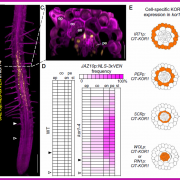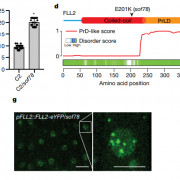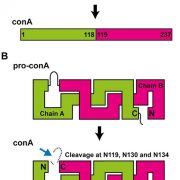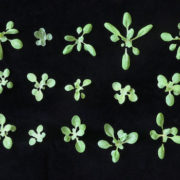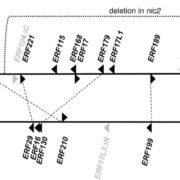Vascular transcription factors guide plant epidermal responses to limiting phosphate conditions (Science)
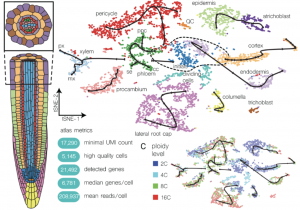 Plants produce more root hairs (epidermal projections) in response to low soil phosphate and the detailed mechanism of this developmental response remains elusive. TARGET OF MONOPTEROS 5 (TMO5) and LONESOME HIGHWAY (LHW) are vascular specific bHLH proteins that work as a heterodimer to activate the rate limiting enzyme LONELY GUY4 (LOG4) in cytokinin biosynthesis. Based on the available literature it is difficult to envision any connection between these vascular specific TMO5/LHW and epidermal cell morphology. In this paper, Wendrich, Yang, Vandamme, Verstaen et al., identified a cell non-autonomous function of TMO5/LHW in root hair cell formation under low phosphate conditions. The authors used 10X genomics single cell RNA-Seq in Arabidopsis roots to generate a high-resolution gene expression atlas and identified that 47 target genes of TMO5/LHW are exclusively expressed in roots hairs. Single and double mutants of TMO5 and TMO5-LIKE1 do not show any abnormal root hair phenotype under normal conditions but are required for root hair formation under low phosphate conditions. Under low phosphate conditions TMO5 expression increases in the root vasculature producing more cytokinin which diffuses to the epidermal cells to activate TMO5 target genes. Further, vascular-specific increase or decrease of cytokinin signaling shows increased or decreased root hair phenotype respectively. Thus, this paper identifies the mechanism by which vascular-specific transcription factors activates cytokinin as a mediator to induce root hairs in cell non-autonomous manner. Summary by (Vijaya Batthula @Vijaya_Batthula) Science 10.1126/science.aay4970
Plants produce more root hairs (epidermal projections) in response to low soil phosphate and the detailed mechanism of this developmental response remains elusive. TARGET OF MONOPTEROS 5 (TMO5) and LONESOME HIGHWAY (LHW) are vascular specific bHLH proteins that work as a heterodimer to activate the rate limiting enzyme LONELY GUY4 (LOG4) in cytokinin biosynthesis. Based on the available literature it is difficult to envision any connection between these vascular specific TMO5/LHW and epidermal cell morphology. In this paper, Wendrich, Yang, Vandamme, Verstaen et al., identified a cell non-autonomous function of TMO5/LHW in root hair cell formation under low phosphate conditions. The authors used 10X genomics single cell RNA-Seq in Arabidopsis roots to generate a high-resolution gene expression atlas and identified that 47 target genes of TMO5/LHW are exclusively expressed in roots hairs. Single and double mutants of TMO5 and TMO5-LIKE1 do not show any abnormal root hair phenotype under normal conditions but are required for root hair formation under low phosphate conditions. Under low phosphate conditions TMO5 expression increases in the root vasculature producing more cytokinin which diffuses to the epidermal cells to activate TMO5 target genes. Further, vascular-specific increase or decrease of cytokinin signaling shows increased or decreased root hair phenotype respectively. Thus, this paper identifies the mechanism by which vascular-specific transcription factors activates cytokinin as a mediator to induce root hairs in cell non-autonomous manner. Summary by (Vijaya Batthula @Vijaya_Batthula) Science 10.1126/science.aay4970


